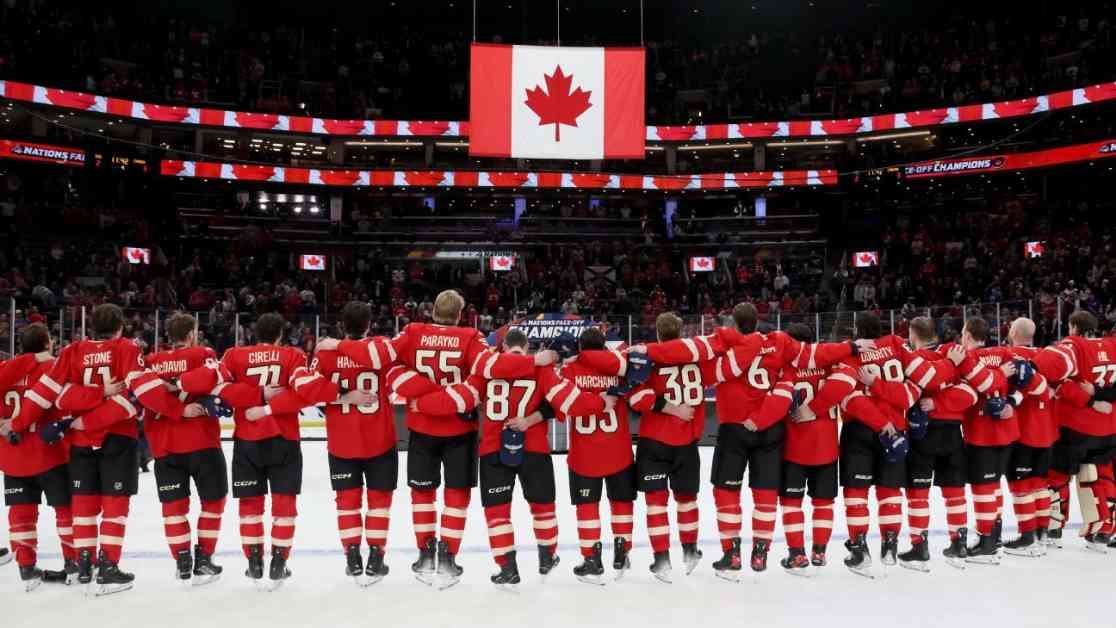In a thrilling showdown at the 4 Nations Face-Off tournament, Canada and the United States collided in a spectacle that left fans on the edge of their seats. The intense matchup between these two hockey powerhouses was a prelude to an epic overtime finale that saw Connor McDavid emerge as the hero of the day.
Grading the Teams
Canada: A
Heading into the game, Canada boasted a star-studded lineup, but it was evident that relying solely on their top lines would not be enough to overcome the equally talented American team. Coach Jon Cooper’s strategic decision to tap into the depth of his roster proved crucial, with the addition of Cale Makar on defense adding a significant boost.
Despite facing challenges in getting key players like Mitch Marner and Sidney Crosby on the scoreboard, Canada’s ability to crack the formidable Connor Hellebuyck showcased their savvy gameplay. The victory, sealed by McDavid’s overtime goal, was a testament to Canada’s resilience and adaptability in a closely contested match.
United States: A-
The United States approached the final with finesse, opting for a strategic game plan over brute force. Standout performances from players like Jake Guentzel and Jaccob Slavin highlighted the team’s depth and versatility, with Slavin earning praise as a defensive stalwart.
While individual brilliance shone through for the U.S., the team’s slow start allowed Canada to dictate the pace early on. The Americans’ ability to shift momentum in the final period raised questions about what might have been if they had applied more pressure from the outset.
Key Takeaways
Depth Makes a Difference
Both teams showcased the impact of depth players in the final, with skaters like Jake Sanderson and Sam Bennett stepping up when it mattered most. Bennett’s role in drawing penalties and Sanderson’s opportunistic goal underscored the importance of roster versatility in high-stakes tournaments.
The unpredictability of injuries further emphasized the need for teams to trust their bench strength, as showcased by Thomas Harley seamlessly filling in for injured players. In a game as closely contested as this one, the contributions of unsung heroes often prove decisive in shifting the momentum.
Goaltending Hardly a Great Divide
Amidst speculation about the goaltending duel between Jordan Binnington and Connor Hellebuyck, both netminders delivered standout performances. Binnington’s heroics in overtime, including crucial saves on star players like Auston Matthews, solidified his status as Canada’s OT MVP.
Hellebuyck’s exceptional play mirrored Binnington’s prowess, highlighting the parity between the two elite goalies. The intense battle between these netminders served as a testament to their skill and composure under pressure, with neither deserving blame for the final outcome.
Player to Watch in the Buildup to the Olympics
Sidney Crosby, F, Canada
As a veteran leader for Team Canada, Sidney Crosby’s enduring impact on the ice was evident throughout the tournament. Despite battling injuries, Crosby’s offensive contributions and leadership were instrumental in guiding his team to victory.
Looking ahead to the 2026 Olympic Games, Crosby’s role as a linchpin for Canada raises questions about his ability to maintain peak performance amidst the rigors of another NHL season. With emerging talents vying for roster spots, Crosby’s continued excellence will be pivotal in shaping Canada’s prospects in Italy.
Auston Matthews, F, United States
Despite a subdued showing in the 4 Nations tournament, Auston Matthews’ potential as a game-changing talent for the U.S. remains undeniable. As a generational scorer and team captain, Matthews’ ability to stay healthy and elevate his game will be critical to the American team’s success in future competitions.
The USA’s fortunes in the upcoming Olympics hinge on Matthews’ form and fitness, underscoring the importance of managing his workload and ensuring he enters the Games at the peak of his abilities.
Lingering Questions for the Olympics
How Will Canada Approach its Goaltending?
Canada’s goaltending decisions came under scrutiny during the tournament, with questions lingering about the team’s starter for the Olympics. The debate over Logan Thompson’s absence from the roster and the performances of other potential candidates like Stuart Skinner and Darcy Kuemper adds intrigue to Canada’s netminding situation.
As the team evaluates its options between the pipes, striking a balance between experience and potential will be crucial in determining the optimal goaltending strategy for the Winter Games. The competition for the No.1 goalie spot promises to be a focal point leading up to the Olympics.
What Will a Healthy USA Blue Line Look Like?
The absence of key defensemen like Quinn Hughes and Charlie McAvoy raised questions about the potential impact of a fully healthy U.S. blue line. While the team showcased offensive prowess and solid goaltending, the defensive unit’s depth and cohesion could be further enhanced with the return of injured players.
A healthy defensive lineup featuring Hughes and McAvoy alongside other top skaters could elevate the USA’s defensive capabilities to new heights, providing a formidable defensive front in international competition. The team’s ability to balance offensive flair with defensive stability will be a key factor in their quest for Olympic success.
As the dust settles on a thrilling 4 Nations tournament, the stage is set for an exciting buildup to the 2026 Winter Olympics. With star players showcasing their talents and teams honing their strategies, the road to Italy promises to be filled with anticipation and intrigue, setting the stage for a riveting hockey spectacle.





















